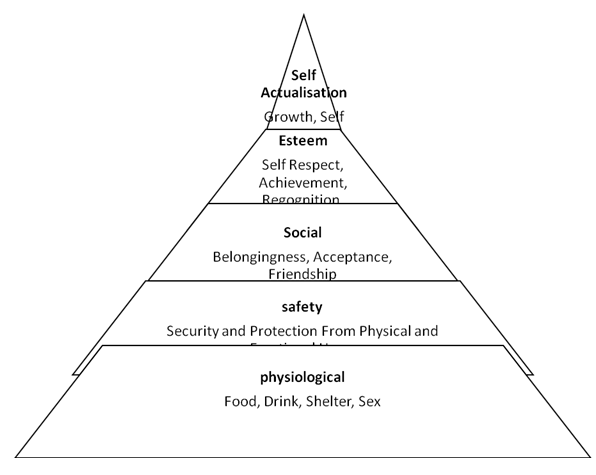1. Maslow’s Hierarchy of Needs
Figure 3.1: Maslow’s Hierarchy of Needs
- Needs were categorized as five levels of lower- to higher order needs.
- Individuals must satisfy lower-order needs before they can satisfy higher order needs.
- Satisfied needs will no longer motivate.
- Motivating a person depends on knowing at what level that person is on the hierarchy.
- Hierarchy of needs
- Lower-order (external): physiological, safety
- Higher-order (internal): social, esteem, self-actualization
- The difference is that higher order needs are satisfied internally while lower-order needs are satisfied externally.
2. McGregor’s Theory X and Y
Douglas McGregor (1960) produced his analysis of the different views about people and how they should be motivated. Theory X is the traditional view that the average human dislikes work and wishes to avoid responsibility and that, therefore, ‘most people must be coerced, controlled, directed, threatened with punishment to get them to put forward adequate effort towards organizational objectives’. In contrast, theory Y emphasizes that people will exercise self-direction in the service of objectives to which they are committed and that commitment to objectives is a function of the rewards associated with their achievement.
3. Herzberg’s Two Factor Theory
- Job satisfaction and job dissatisfaction are created by different factors.
- Hygiene factors: extrinsic (environmental) factors that create job dissatisfaction.
- Motivators: intrinsic (psychological) factors that create job satisfaction.
- Attempted to explain why job satisfaction does not result in increased performance.
- The opposite of satisfaction is not dissatisfaction, but rather no satisfaction.
Herzberg Two-Factor theory divides Maslow’s Hierarchy into a lower-level and a higher-level set of needs, and suggests that the best way to provide motivation for an employee is to offer to satisfy the person’s higher-order needs, ego and self-actualization. Herzberg said that lower-order needs, or hygiene factors, are different from higher-order needs, or motivators. He maintains that adding more hygiene factors to the job is a very bad way to motivate because lower-order needs are quickly satisfied.
4. Hawthorne Studies
Led by Elton Mayo (1939) with a research team from Harvard University who were interested in find out how changes in work environment impact productivity. Four major phases marked Hawthorne Studies;
- The illumination studies: designed to determine the influence of lighting on worker productivity. No significant difference in productivity
- The relay assembly test room studies: changes such as incentive plans, rest periods, temperature, humidity, work hours and refreshments. Productivity went up in wide variety of situations
- The interview program: interviews were held with employees to learn more about the impact of working conditions on productivity. Workers were more interested in talking about their feelings and attitudes
- The bank wiring room studies: workers were observed in a bank wiring room. It emerged that workers developed norms regarding ‘proper’ level of productivity and exerted pressure on each other to maintain that level.

